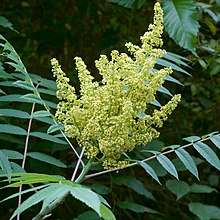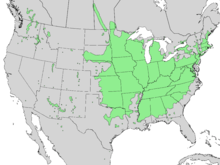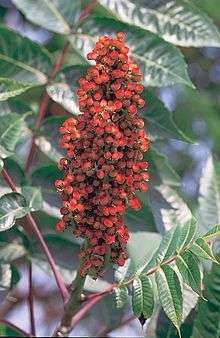Rhus glabra
Rhus glabra, the smooth sumac,[2] (also known as white sumac, upland sumac, or scarlet sumac)[3] is a species of sumac in the family Anacardiaceae, native to North America, from southern Quebec west to southern British Columbia in Canada, and south to northern Florida and Arizona in the United States and Tamaulipas in northeastern Mexico.
| Rhus glabra | |
|---|---|
 | |
| Rhus glabra flowers | |
| Scientific classification | |
| Kingdom: | Plantae |
| Clade: | Tracheophytes |
| Clade: | Angiosperms |
| Clade: | Eudicots |
| Clade: | Rosids |
| Order: | Sapindales |
| Family: | Anacardiaceae |
| Genus: | Rhus |
| Species: | R. glabra |
| Binomial name | |
| Rhus glabra | |
 | |
| Natural range of Rhus glabra | |
One of the easiest shrubs to identify throughout the year (unless mistaken for poison sumac, in the absence of mature fruit), smooth sumac has a spreading, open-growing shrub growing up to 3 m (9.8 ft) tall, rarely to 5 m (16 ft). The leaves are alternate, 30–50 cm (12–20 in) long, compound with 11–31 oppositely paired leaflets, each leaflet 5–11 cm (2–4 1⁄4 in) long, with a serrated margin. The leaves turn scarlet in the fall. The flowers are tiny, green, produced in dense erect panicles 10–25 cm (4–10 in) tall, in the spring, later followed by large panicles of edible crimson berries that remain throughout the winter. The buds are small, covered with brown hair and borne on fat, hairless twigs. The bark on older wood is smooth and grey to brown.

In late summer it sometimes forms galls on the underside of leaves, caused by the parasitic sumac leaf gall aphid, Melaphis rhois. The galls are not harmful to the tree.
Uses
Native Americans ate the young sprouts as a salad.[4] The fruit is sour and contains a large seed, but can be chewed (to alleviate thirst) and made into a lemonade-like drink. Deer forage the twigs and fruit.[5] In 2020, archaeologists unearthed a pipe at a dig in Central Washington state, showing chemical evidence that a Native American tribe had smoked Rhus glabra either alone or in a blend with tobacco, perhaps "for its medicinal qualities and to improve the flavor of smoke."[6]
References
- Botanic Gardens Conservation International (BGCI).; IUCN SSC Global Tree Specialist Group. (2018). "Rhus glabra". IUCN Red List of Threatened Species. 2018: e.T124270038A135957581. doi:10.2305/IUCN.UK.2018-2.RLTS.T124270038A135957581.en. Retrieved 3 May 2020.
- "Rhus glabra". Natural Resources Conservation Service PLANTS Database. USDA. Retrieved 21 October 2015.
- "American Sumac". USDA Department bulletin. 706. 1920. Retrieved 30 April 2017.
- Little, Elbert L. (1980). The Audubon Society Field Guide to North American Trees: Eastern Region. New York: Knopf. p. 549. ISBN 0-394-50760-6.
- Little, Elbert L. (1994) [1980]. The Audubon Society Field Guide to North American Trees: Western Region (Chanticleer Press ed.). Knopf. p. 519. ISBN 0394507614.
- An Ancient Residue Metabolomics-Based Method to Distinguish Use of Closely Related Plant Species in Ancient Pipes
External links
- Bioimages: Rhus glabra
- Smooth Sumac on eNature
- Smooth Sumac of Kansas
- Identifying Invasive Plants Detailed photos to distinguish Smooth Sumac from similar plants
- Vegetation Management Guideline Control Recommendations
- Non-tobacco plant identified in ancient pipe for first time
| Wikimedia Commons has media related to Rhus glabra. |
